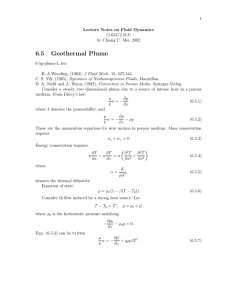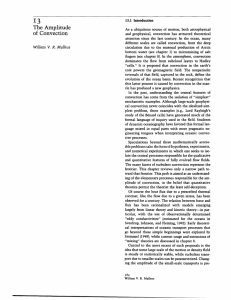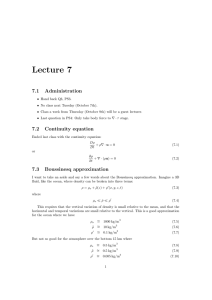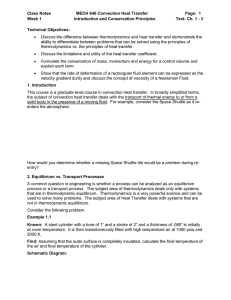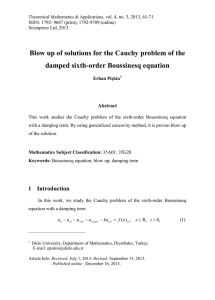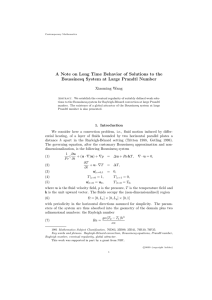4.2 Approximations for small temperature variation 4.2.1 Mass conservation and almost incompressibilty
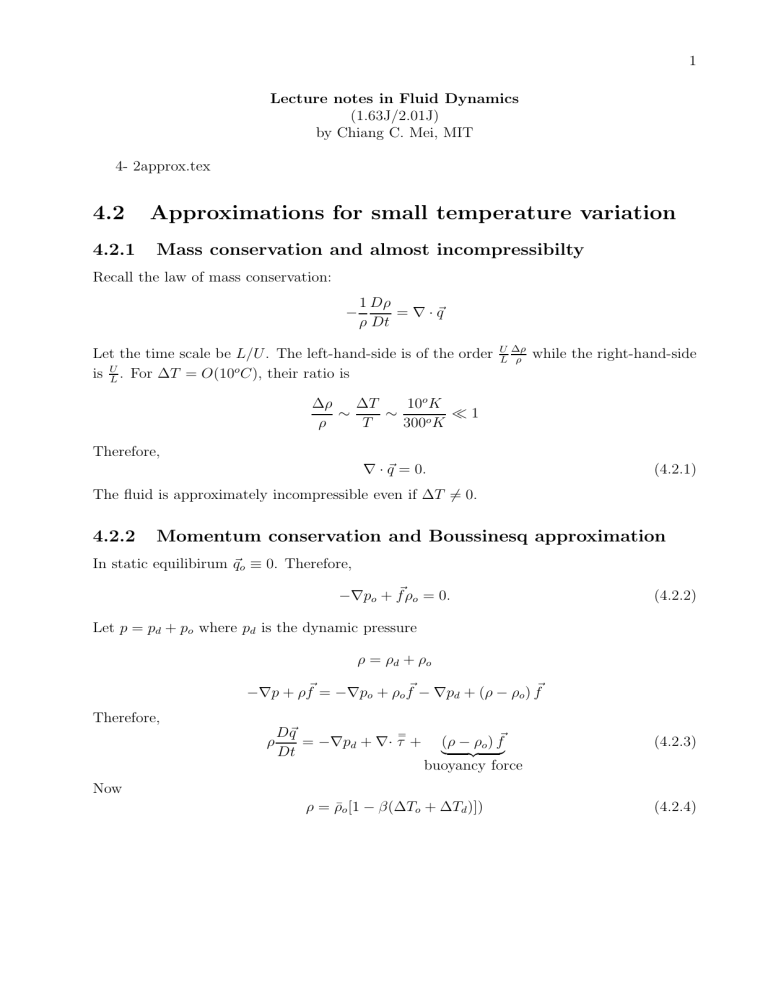
Lecture notes in Fluid Dynamics
(1.63J/2.01J) by Chiang C. Mei, MIT
4- 2approx.tex
4.2
Approximations for small temperature variation
4.2.1
Mass conservation and almost incompressibilty
Recall the law of mass conservation:
−
1
ρ
Dρ
Dt
= ∇ · ~q
Let the time scale be L/U . The left-hand-side is of the order is U
L
. For ∆ T = O (10 o C ), their ratio is
U
L
∆ ρ
ρ while the right-hand-side
∆ ρ
ρ
∼
∆ T
T
∼
10 o K
300 o K
1
Therefore,
∇ · ~q = 0 .
The fluid is approximately incompressible even if ∆ T = 0.
(4.2.1)
4.2.2
Momentum conservation and Boussinesq approximation
In static equilibirum ~q o
≡ 0. Therefore,
(4.2.2) −∇ p o
+
Let p = p d
+ p o where p d is the dynamic pressure o
= 0 .
ρ = ρ d
+ ρ o
−∇ p + ρ ~ = −∇ p o
+ ρ o
~
− ∇ p d
+ ( ρ − ρ o
) f
~
Therefore,
ρ
D~q
Dt
= −∇ p d
+ ∇·
=
τ + ( ρ − ρ o
)
| {z } buoyancy force
Now
ρ = ¯ o
[1 − β (∆ T o
+ ∆ T d
)])
(4.2.3)
(4.2.4)
1
2
Hence
ρ o
ρ o
(1 − β ∆ T o
) , ρ d
= − ¯ o
β ∆ T d
, and
( ρ − ρ o
)
~
= − ¯ o
( − g ) β ∆ T d
~k
= ¯ o gβ ∆ T d
~k
(4.2.5)
For mildly varying ρ o
ρ o and small ρ − ρ o
, we ignore the variation of density and approximate by a constant everywhere, except in the body force. This is called the Boussinesq approximation . Thus
¯ o
D~q
Dt
= −∇ p d
+ ∇·
=
τ ρ o gβ ∆ T d
~k
(4.2.6) where
¯ o
= ρ o
( z = 0)
4.2.3
Total energy
Using Eqn. (4.2.1) in Eqn. ( ??
) and the Boussinesq approximation
ρ ¯ o
C
DT
Dt
=
∂
∂x i
K
∂T
∂x i
+ Φ (4.2.7)
Here T is the total temperature (static + dynamic).
Now
Φ µU 2 /L 2 µ
∼ ∼
ρ o
C DT
Dt
ρ o
C U ∆ T
L
ρ o
U L
U 2
C ∆ T where
U 2
E =
C ∆ T
= Eckart No.
, Re =
ρU L
µ
=
E
Re
= Reynolds No.
In environmental problems, ∆ T ∼ 10 o K, L ∼ 10 m, U ∼ 1 m/sec , the last two columns of
Table 4.1: Typical values E/Re for air and water
ν ( cm 2 /s )
β (1 / ◦ K )
Water
C (erg/s-gr◦ K ) 4 × 10 7
K (ergs-cm◦ K ) 0 .
6 × 10 5
10 2
10 − 3
E
Re
0 .
25 × 10 − 2
10 5
Air
10 7
0 .
3 × 10 5
2 × 10 − 2
1/300
10 − 4
0 .
5 × 10 5
Table 4.1 is obtained. Hence Φ is negligible, and
ρ o
C
DT
Dt
=
∂
∂x i
K
∂T
∂x i
(4.2.8)
3
Only convection and diffusion are dominant. This is typical in natural convectin problems.
Remark 1.
In many engineering problems (aerodynamics, rocket reentry, etc.), heat is caused by frictional dissipation in the flow, therefore, Φ is important. These are called forced convection problems. In environmental problems, flow is often the result of heat addition.
Here the flow problems are referred to as the natural convection .
Remark 2 : Since ¯ appears as a derivative only, only the variation of T , i.e., the difference T − T
¯ o matters, where ¯ o is a reference temperature.
Remark 3 : In turbulent natural convection u = ¯ + u 0 T = ¯ + T 0 (4.2.9)
Averaging Eqn. (4.2.8)
ρ o c
D
¯
Dt
= −
|
∂
ρ o c
∂x
{z i u 0 i
T 0
} heat flux by turbulence
∂
+
∂x i
∂
K
∂x i
(4.2.10)
If the the correlation term is modeled as eddy diffusion, the form would be similar to (4.2.8).






